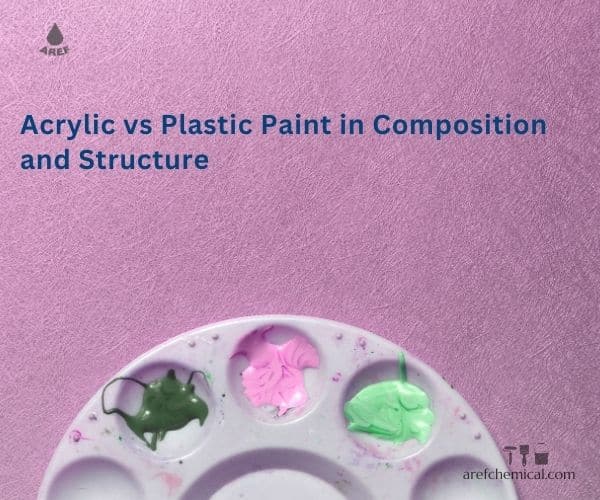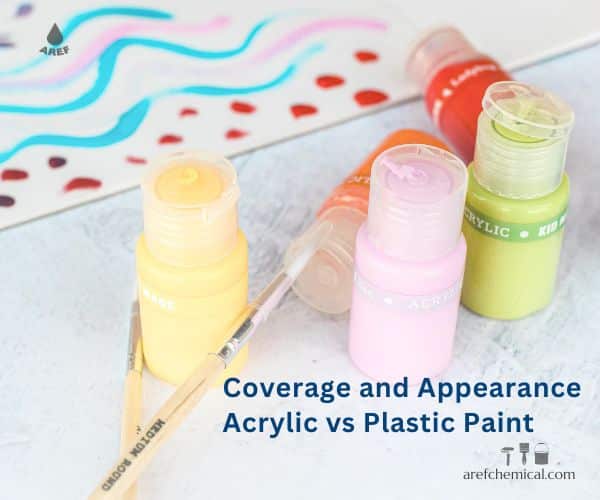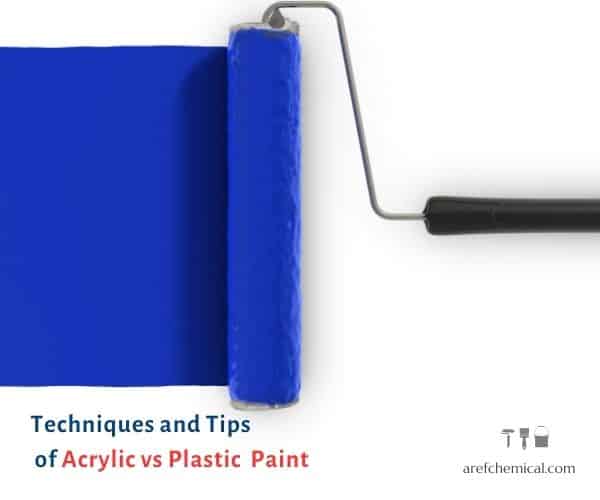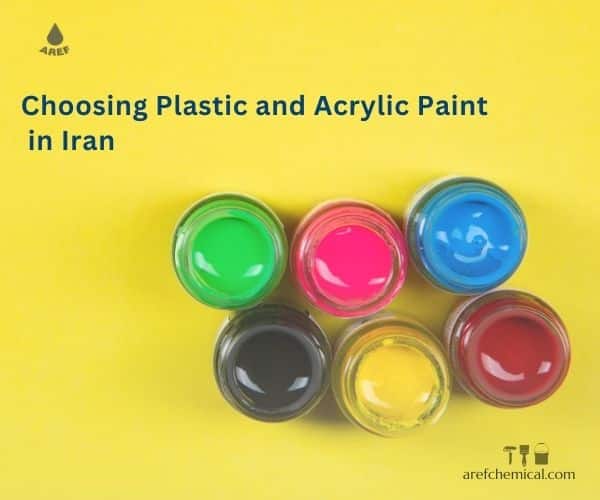Plastic and acrylic paint are both the most popular types of paint in the construction industry and interior decoration. However, the color difference between plastic and acrylic is very noticeable. Also, knowing these differences will help you choose the best option for art and construction projects. Choosing between plastic and acrylic paint depends on several factors. Plastic paint is an economical option suitable for low-traffic interior spaces, while acrylic paint is an ideal choice for a variety of interior and exterior projects due to its high durability, excellent resistance, and versatility. In this article, we will examine Acrylic vs Plastic Paint.
Acrylic vs plastic paint in composition and structure
Plastic paint is water-based. Its resin is usually polyvinyl acetate (PVA). It also has larger resin particles. Of course, acrylic paint is also water-based and has acrylic resin or acrylic styrene. Finer resin particles are also characteristic.
Color variety and combinability
Plastic color
– Relative limitation in color variety
-Difficulty in creating custom colors
– less color stability after drying (difference between wet and dry color)
Acrylic paint
– Very high color variety
– Easy blending to create custom colors
– More stability of color after drying (more compatibility between wet and dry color)
Acrylic vs plastic paint in chemical and physical properties
Plastic color
– pH: usually between 7.5 and 9
– Density: about 1.3 to 1.5 grams per cubic centimeter
– Viscosity: 95-110 KU (Krebs unit)
– Solid percentage: 35-45%
Acrylic paint
– pH: usually between 8 and 9.5
– Density: about 1.2 to 1.4 grams per cubic centimeter
– Viscosity: 100-120 KU
– Solid percentage: 45-55%
Durability and resistance
Acrylic vs plastic paint in terms of durability and resistance, plastic paint has less resistance to wear and washing. The lack of resistance to moisture and steam is one of the other things. It is suitable for indoor spaces with low traffic.
Acrylic paint is highly resistant to wear and washing. It is also resistant to moisture, steam, and temperature changes. It is suitable for indoor and outdoor spaces with high traffic.
The effect of light and the passage of time
Plastic color
– Less resistance to UV rays
– Possibility of yellowing and color change over time
– Decreasing quality and adhesion over time
Acrylic paint
– High resistance to UV rays
– Better color stability over time
– Maintaining quality and adhesion for a longer period of time
Compatibility with different levels
Plastic color
– Suitable for plaster, cement, and wooden surfaces
– Less adhesion to smooth and non-porous surfaces
– The need for special lining for metal surfaces
Acrylic paint
Compatible with a wide range of surfaces including plaster, cement, wood, metal, and plastic
– Excellent adhesion to most surfaces
– Can be used directly on metal surfaces with proper preparation
Coverage and appearance
Acrylic vs plastic paint in terms of coating and appearance, plastic paint has a good coating, matte appearance, and the possibility of creating texture on the surface.
Acrylic paint provides excellent coverage, a variety of gloss levels (from matte to glossy), and a smooth and uniform surface.
Drying time and smell
Plastic paint dries faster (usually 1-2 hours) and has less odor. This is the most important difference between plastic and acrylic paint.
Acrylic paint dries relatively slower (usually 2-4 hours) and has a stronger smell (but less than oil paints).
Price and economy
Cost has always been an important issue. Plastic paint is generally cheaper and more readily available. Acrylic paint is more expensive, but because of its high durability, it can be cost-effective in the long run.
Plastic color
– Cheaper
Need more layers for full coverage
– Shorter lifespan and need to repaint sooner
Acrylic paint
– More expensive
– Need less layers for full coverage
– Longer lifespan and higher durability
To choose the best option, it is necessary to consider the environmental conditions, surface type, budget, and long-term goals of the project. Also, consulting color and decoration experts can help you make the final decision.
Applications
Both of these colors are quite functional.
Plastic color
– Ceilings and internal walls
– Low-traffic areas
– Projects with a limited budget
Acrylic paint
– Internal and external walls
– Kitchen and bathroom
– High-traffic areas
– Surfaces exposed to moisture and temperature changes
Application techniques and practical for tips of plastic paint
– Need less surface preparation
– The possibility of using a roller, brush, or spray
– It is better to apply at a temperature between 10 and 35 degrees Celsius
– Usually requires 2-3 coats for full coverage
– Waiting time between layers: about 2-3 hours
Application techniques and practical tips for acrylic paint
– The need for more detailed surface preparation (sanding, primer)
– Can be applied with a roller, brush, spray, and even a spatula
– The best temperature for execution: 15 to 30 degrees Celsius
– Usually, 1-2 layers are enough for full coverage
– Waiting time between layers: about 4-6 hours
Ease of use and maintenance
Plastic color, easy application, ability to dilute with water, cleaning tools with water, and difficulty in cleaning painted surfaces can be considered as the difference between plastic color and acrylic.
Acrylic paint is relatively easy to apply and can be diluted with water. It is easy to clean the tool with water, and the ease of cleaning the painted surfaces is another feature.
Ability to repair and rebuild
Plastic color
– Relatively difficult repair
– The possibility of creating stains in case of local repair
– The need to repaint the entire surface in case of serious damage
– Easier repair capability
– The possibility of local repair without creating a noticeable stain or color difference
– Better adhesion of the new layer to the old layer
Remember that the quality of execution and proper preparation of the surface, regardless of the type of color chosen, plays a vital role in achieving a desirable and lasting result.
Environmental effects
In terms of effects on the environment, it can be stated as follows:
Plastic color
– Less VOC (volatile organic compounds).
– More compatibility with the environment
Acrylic paint
– More VOC than plastic paint
– The presence of low VOC and environmentally friendly types
Impact on indoor air quality
Plastic color
– Less VOC emission after drying
– Suitable for people sensitive to smells and chemicals
– No absorption of odors and air pollution
Acrylic paint
– More VOC emissions, even after drying (although less than oil paints)
– Presence of low VOC types for sensitive people
– Some types have the property of absorbing and neutralizing odors and air pollutants
Choosing plastic and acrylic paint in Iran
Iran has a relatively strong paint production industry. Reputable companies such as Arefchemical Paints are active in paint production. Plastic paint is still the most popular choice for interior use. Acrylic paint has become more popular in recent years, especially in luxury projects and commercial buildings.
Climatic conditions in Iran and the use of paint
– In humid northern regions, acrylic paints are preferred due to their better resistance to moisture.
– In hot and dry central and southern regions, plastic colors are still popular for interior spaces.
Special applications
– For the exterior of buildings, especially in big cities, the use of acrylic paints is increasing.
– In historical buildings and traditional textures, special colors such as mineral or silicate colors are sometimes used.
Color standards and rules in Iran
Iran’s National Standard Organization has set standards for the quality of paints. National Standard 289 sets specific requirements for water-based construction paints (including plastic and acrylic). In recent years, more attention has been paid to the use of low-VOC paints. Some municipalities, especially in big cities, encourage the use of environmentally friendly paints.
Practical recommendations for Iranian consumers
– For low-traffic interior spaces with a limited budget, plastic paint is still a good option.
– For high-traffic spaces, kitchen, bathroom, and exterior, it is recommended to use quality acrylic paints.
– Avoid buying fake or low-quality colors.
– Look for products with national standards and a valid warranty.
– To achieve the best result, use professional and experienced painters.
– Don’t forget to prepare the surface properly before painting.
– To increase the life of the paint, avoid repeated washing of painted surfaces with strong detergents.
– If you need to clean, use a soft and wet cloth.
By considering acrylic vs plastic paint Iranian consumers can make a more informed choice about the type of paint used in their projects and benefit from the advantages of both types of plastic and acrylic paint in the best way.
summary
In this article, we stated acrylic vs plastic paint. Choosing between plastic and acrylic paint depends on several factors, including the type of surface, location of use, budget, and specific project needs. Plastic paint is a cost-effective option for low-traffic interior spaces, while high-durability acrylic paint is a good choice for high-traffic spaces and exterior surfaces. By considering all aspects and features of each of these colors, you can make the best choice for your project.








18 Responses
🔥👌👌
good information about Acrylic vs Plastic Paint
👌👌 perfect Acrylic vs Plastic Paint
❤️🔥 acrylic paints are preferred
Acrylic vs plastic paint in chemical and physical properties are so important these days
It is necessary to consider the environmental conditions, surface type, budget, and long-term goals of the project. Also, consulting color and decoration experts can help you make the final decision.
Iran’s National Standard Organization has established National Standard 289, which outlines specific quality requirements for water-based construction paints, including plastic and acrylic types. Recently, there has been an increased focus on low-VOC (volatile organic compounds) paints, with some municipalities, particularly in larger cities, promoting the use of environmentally friendly options.
The choice between acrylic paint and plastic paint depends on your specific needs and application.
Water-based paint made with acrylic resins. Generally has a matte to satin finish and can be glossy when varnished.
Acrylic Paint Dries relatively quickly, usually within 20-30 minutes for thin layers.
Acrylic Paint has good flexibility and can be used on a variety of surfaces, including canvas, wood, and paper. Maintains vibrant color over time without significant fading.
Plastic Paint often refers to paint specifically designed for synthetic surfaces or surfaces that require extreme durability.
Plastic Paint often refers to paint specifically designed for synthetic surfaces or surfaces that require extreme durability. Typically available in various finishes, including glossy, satin, and matte.
Plastic paint consists of water-based plastic resins and is usually used to paint interior and exterior surfaces.
Acrylic paint is made of acrylic resins and can be water-based or solvent-based. These colors are usually more resistant to water and sun.
Plastic paint adheres well to various surfaces, but may not be very resistant to water and moisture.
Due to its high adhesiveness, acrylic paint adheres well to non-absorbable surfaces and is more resistant to atmospheric factors.
Because of its excellent properties, acrylic paint is a better choice for exterior surfaces and areas exposed to water and UV.